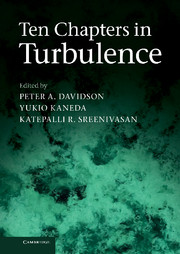Book contents
- Frontmatter
- Contents
- Preface
- Contributors
- 1 Small-Scale Statistics and Structure of Turbulence – in the Light of High Resolution Direct Numerical Simulation
- 2 Structure and Dynamics of Vorticity in Turbulence
- 3 Passive Scalar Transport in Turbulence: A Computational Perspective
- 4 A Lagrangian View of Turbulent Dispersion and Mixing
- 5 The Eddies and Scales of Wall Turbulence
- 6 Dynamics of Wall-Bounded Turbulence
- 7 Recent Progress in Stratified Turbulence
- 8 Rapidly-Rotating Turbulence: An Experimental Perspective
- 9 MHD Dynamos and Turbulence
- 10 How Similar is Quantum Turbulence to Classical Turbulence?
- References
10 - How Similar is Quantum Turbulence to Classical Turbulence?
Published online by Cambridge University Press: 05 February 2013
- Frontmatter
- Contents
- Preface
- Contributors
- 1 Small-Scale Statistics and Structure of Turbulence – in the Light of High Resolution Direct Numerical Simulation
- 2 Structure and Dynamics of Vorticity in Turbulence
- 3 Passive Scalar Transport in Turbulence: A Computational Perspective
- 4 A Lagrangian View of Turbulent Dispersion and Mixing
- 5 The Eddies and Scales of Wall Turbulence
- 6 Dynamics of Wall-Bounded Turbulence
- 7 Recent Progress in Stratified Turbulence
- 8 Rapidly-Rotating Turbulence: An Experimental Perspective
- 9 MHD Dynamos and Turbulence
- 10 How Similar is Quantum Turbulence to Classical Turbulence?
- References
Summary
Introduction
Superfluids can flow without friction and display two-fluid phenomena. These two properties, which have quantum mechanical origins, lie outside common experience with classical fluids. The subject of superfluids has thus generally been relegated to the backwaters of mainstream fluid dynamics. The focus of low-temperature physicists has been the microscopic structure of superfluids, which does not naturally invite the attention of experts on classical fluids. However, perhaps amazingly, there exists a state of superfluid flow that is similar to classical turbulence, qualitatively and quantitatively, in which superfluids are endowed with quasiclassical properties such as effective friction and finite heat conductivity. This state is called superfluid or quantum turbulence (QT) [Feynman (1955); Vinen & Niemela (2002); Skrbek (2004); Skrbek & Sreenivasan (2012)]. Although QT differs from classical turbulence in several important respects, many of its properties can often be understood in terms of the existing phenomenology of its classical counterpart. We can also learn new physics about classical turbulence by studying QT. Our goal in this article is to explore this interrelation. Instead of expanding the scope of the article broadly and compromising on details, we will focus on one important aspect: the physics that is common between decaying vortex line density in QT and the decay of three-dimensional (3D) turbulence that is nearly homogeneous and isotropic turbulence (HIT), which has been a cornerstone of many theoretical and modeling advances in hydrodynamic turbulence. A more comprehensive discussion can be found in a recent review by Skrbek & Sreenivasan (2012).
- Type
- Chapter
- Information
- Ten Chapters in Turbulence , pp. 405 - 437Publisher: Cambridge University PressPrint publication year: 2012
References
- 5
- Cited by



